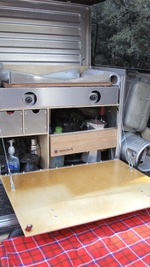
Overland Tech and Travel
Advice from the world's
most experienced overlanders
tests, reviews, opinion, and more
Why I hate Nalgene bottles
 Few outdoor product manufacturers have attained the market dominance enjoyed by the Nalge Company, once an obscure maker of laboratory storage containers, after company president Marsh Hyman discovered his son’s Boy Scout troop was using their one-liter bottles as canteens early in the 1970s. The subsequent rebranding of Nalgene Outdoor Products was successful beyond the wildest dreams of marketing people who had previously relied on guys wearing lab coats and pocket protectors as customers. So successful, in fact, that I seriously doubt anyone reading this has not at some point had a drink of water from a Nalgene.
Few outdoor product manufacturers have attained the market dominance enjoyed by the Nalge Company, once an obscure maker of laboratory storage containers, after company president Marsh Hyman discovered his son’s Boy Scout troop was using their one-liter bottles as canteens early in the 1970s. The subsequent rebranding of Nalgene Outdoor Products was successful beyond the wildest dreams of marketing people who had previously relied on guys wearing lab coats and pocket protectors as customers. So successful, in fact, that I seriously doubt anyone reading this has not at some point had a drink of water from a Nalgene.
I drank the water, and the Kool-Aid, early on. The original one-liter white HDPE bottles with the wide cap were light, tough, and fit perfectly in the side pockets of my Camp Trails frame pack. They were easy to fill from a stream or bucket, and didn’t leak. You could chill the contents with ice cubes, or freeze the whole bottle with impunity. The Austrian Olicamp bottles I’d been using were leakproof and tough, too, but had a tiny opening and a fiddly two-piece top, so—despite years of yeoman service, including a backpacking trip spanning southern Arizona and three mountain ranges—I shelved them and shamelessly embraced their replacements.
 When Nalgenes go bad . . .Few outdoor product manufacturers have attained the market dominance enjoyed by the Nalge Company, once an obscure maker of laboratory storage containers, after company president Marsh Hyman discovered his son’s Boy Scout troop was using their one-liter bottles as canteens early in the 1970s. The subsequent rebranding of Nalgene Outdoor Products was successful beyond the wildest dreams of marketing people who had previously relied on guys wearing lab coats and pocket protectors as customers. So successful, in fact, that I seriously doubt anyone reading this has not at some point had a drink of water from a Nalgene.
When Nalgenes go bad . . .Few outdoor product manufacturers have attained the market dominance enjoyed by the Nalge Company, once an obscure maker of laboratory storage containers, after company president Marsh Hyman discovered his son’s Boy Scout troop was using their one-liter bottles as canteens early in the 1970s. The subsequent rebranding of Nalgene Outdoor Products was successful beyond the wildest dreams of marketing people who had previously relied on guys wearing lab coats and pocket protectors as customers. So successful, in fact, that I seriously doubt anyone reading this has not at some point had a drink of water from a Nalgene.
I drank the water, and the Kool-Aid, early on. The original one-liter white HDPE bottles with the wide cap were light, tough, and fit perfectly in the side pockets of my Camp Trails frame pack. They were easy to fill from a stream or bucket, and didn’t leak. You could chill the contents with ice cubes, or freeze the whole bottle with impunity. The Austrian Olicamp bottles I’d been using were leakproof and tough, too, but had a tiny opening and a fiddly two-piece top, so—despite years of yeoman service, including a backpacking trip spanning southern Arizona and three mountain ranges—I shelved them and shamelessly embraced their replacements.
Smaller Nalgene bottles that soon followed were ideal for toiletries, spices, and first-aid supplies. In fact, so enamored was I of Nalgene products that I spent an absurd sum special-ordering some of the first Nalgene 20-liter jerry cans then available in the U.S. I strapped two of them into my FJ40 and thought it was a pretty stylish setup.
The facade began to crack—literally—a few years later. Previously I’d noticed that the odd small bottle I used for toiletries or other incidentals had degraded. The translucent plastic would turn dull and opaque, then tiny stress cracks would appear. Forceful pressure with a finger would punch right through the material. At first I blamed this on the stuff I was putting in them (although an internal voice chided me that the containers were originally intended for lab use, and thus presumably should stand up to contents a lot more caustic than Suave Green Apple shampoo). But then one morning on a remote beach in Mexico I reached into the back of the Land Cruiser to pull out one of those stylish jerry cans, and the side split open right under the handle, spewing half my water supply into the sand.
Still I doubted my own doubts. UV exposure certainly could have been at fault in the jerry cans’ demise (inspection had shown the second one to be compromised as well)—although I’d had previous plastic water containers last longer. Regardless, my confidence was now shaken. I switched to Nalgene’s harder Lexan water bottles, but wondered why I should have to. The more oxidized white bottles I found in my pile of assorted Nalgenes, the more annoyed I became. (I have no idea if “oxidation” is the correct term for the problem, but that’s what I called it.) Once I narrowly avoided disaster when a camera bouncing around in my center console punched a small hole in an old six-ounce Nalgene bottle of window cleaner I kept there. Fortunately the hole was above the level of the liquid and I discovered it before it tipped over onto the camera.
Whatever the mechanism might be—UV degradation, shampoo corrosion, planned obsolescence (just kidding, Nalgene)—I’ve concluded that white HDPE Nalgene bottles seem to have a finite, potentially annoying or even hazardous, life expectancy. I can’t be sure what it is—given the hodgepodge of examples I’ve purchased over the years, there’s no way to determine the age of a compromised bottle. The apparent capriciousness of it is odd too—one two-liter square bottle I know I’ve had for ten years is still in fine, pliable shape. But the situation has reached the point where I look at every Nalgene not purchased the week before with suspicion—and that’s no way to have to view one’s outdoor equipment. I still use the small bottles for toiletries, having as yet found no leakproof substitute made in as wide a variety of sizes, but, like any disillusioned disciple, my former accolades have turned to acrimony, and I now spurn every Nalgene product for which I can find a reasonable substitute. Steel Wedco or plastic Scepter jerry cans hold bulk water; and an indestructible NATO canteen carries drinking water on hikes.
 30-year-old Olicamp bottles - still good . . .Then again, I just might go back to those Austrian-made Olicamp bottles. You see, out of curiosity, while writing this I dug them out of the recesses of my gear storage—they were right there next to the SVEA stove and Sigg Tourist cook kit. Thirty years after I carried them across southern Arizona, they’re still perfectly usable.
30-year-old Olicamp bottles - still good . . .Then again, I just might go back to those Austrian-made Olicamp bottles. You see, out of curiosity, while writing this I dug them out of the recesses of my gear storage—they were right there next to the SVEA stove and Sigg Tourist cook kit. Thirty years after I carried them across southern Arizona, they’re still perfectly usable.
Anyone at Nalgene listening?
Tested: Kanz Field Kitchen
by Roseann Hanson
When I was little my family had a chuck box for camping. Most of our camping was with the Boy Scouts, for whom my father was a Scoutmaster. His name is Charles, and friends called him Chuck, so I always thought it was his box, spelled with capital letters, as in “Chuck's Box.”
My mind and heart store so many indelible memories associated with that old beat up box . . . cold nights in pine forests (a treat for a desert kid), smoky fires, charred marshmallows, howling coyotes (we pretended they were wolves), tales of the Lost Dutchman Mine in the Superstition Wilderness, and mom serving forth from the chuck box innumerable stews and casseroles, invariably containing Cream of Mushroom Soup. High dining for an 8-year-old.
Fast-forward to 1987: in our third year of married bliss, knowing how much I loved the old family box, Jonathan built me a wooden chuck box, varnished as lovingly as an Alden schooner. It had a piano-hinged drop-down front, cork lining, silverware drawer, plate slots, shelves, and a secret panel along the back of the drawer, with a row of cutout leaping dolphins. Used on our first and subsequently countless trips to Baja and Sonora, throughout the American West and even the Arctic—first in my ‘78 JF55 and then in several Toyota pickups—it logged 75,000 miles+ of exploration.
Alas, it was retired when we upscaled to a Four Wheel Camper in the late 1990s. But lately, I had been missing my old chuck box (which is retired to a place of honor in storage, with our original Sigg cook set and brass Svea stove). I'm back to camping out of a classic Land Cruiser, so when I had a chance to test out the Kanz Field Kitchen, I jumped at it.
by Roseann Hanson
When I was little my family had a chuck box for camping. Most of our camping was with the Boy Scouts, for whom my father was a Scoutmaster. His name is Charles, and friends called him Chuck, so I always thought it was his box, spelled with capital letters, as in “Chuck's Box.”
My mind and heart store so many indelible memories associated with that old beat up box . . . cold nights in pine forests (a treat for a desert kid), smoky fires, charred marshmallows, howling coyotes (we pretended they were wolves), tales of the Lost Dutchman Mine in the Superstition Wilderness, and mom serving forth from the chuck box innumerable stews and casseroles, invariably containing Cream of Mushroom Soup. High dining for an 8-year-old.
Fast-forward to 1987: in our third year of married bliss, knowing how much I loved the old family box, Jonathan built me a wooden chuck box, varnished as lovingly as an Alden schooner. It had a piano-hinged drop-down front, cork lining, silverware drawer, plate slots, shelves, and a secret panel along the back of the drawer, with a row of cutout leaping dolphins. Used on our first and subsequently countless trips to Baja and Sonora, throughout the American West and even the Arctic—first in my ‘78 JF55 and then in several Toyota pickups—it logged 75,000 miles+ of exploration.
Alas, it was retired when we upscaled to a Four Wheel Camper in the late 1990s. But lately, I had been missing my old chuck box (which is retired to a place of honor in storage, with our original Sigg cook set and brass Svea stove). I'm back to camping out of a classic Land Cruiser, so when I had a chance to test out the Kanz Field Kitchen, I jumped at it.
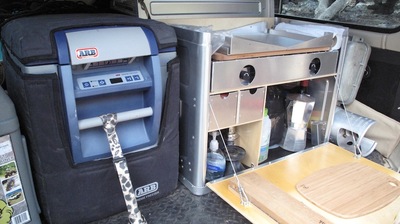 I was intimidated at first. Fully half again as large as my old box, the 19" x 25" x 15" Kanz is gleaming burnished aluminum with beautiful satin-finished Baltic birch. I could lift and carry the old box, but the Kanz takes two of us. This is because it is a kitchen, not just a chuck box; included with our kit is the 22" Partner Steel stove and Kanz's own complete cookware / utensil set. The box + stove is 36 pounds (40 with the Coleman dual-fuel), and 52 with cookware etc. (Kanz's set includes a top-line Snow Peak cookset, Kanz' own double-wall mugs, a percolator, enamelware, and flatware).
I was intimidated at first. Fully half again as large as my old box, the 19" x 25" x 15" Kanz is gleaming burnished aluminum with beautiful satin-finished Baltic birch. I could lift and carry the old box, but the Kanz takes two of us. This is because it is a kitchen, not just a chuck box; included with our kit is the 22" Partner Steel stove and Kanz's own complete cookware / utensil set. The box + stove is 36 pounds (40 with the Coleman dual-fuel), and 52 with cookware etc. (Kanz's set includes a top-line Snow Peak cookset, Kanz' own double-wall mugs, a percolator, enamelware, and flatware).
It is hard to come up with any engineering complaints about this kitchen. Designed over a 12-year period by industrial designer Harald Kanz, the kitchen is the embodiment of German meticulousness for detail and quality. As a young boy, Harald's imagination was captivated by stories of adventure and exploration, he’s said. Fascinated by how things work in the outdoors, he sketched his first tent designs and fire setups while on camping trips with his parents in Germany.
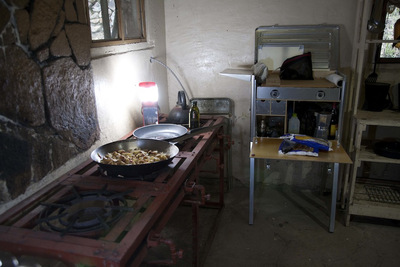 On a recent science expedition to the Sierra Madre in Mexico, we used the Kanz Field Kitchen to augment the very rudimentary kitchen at the old camp.The Kanz Kitchen’s easily detachable legs (fitted with clever pressure springs that you don’t have to fuss with, they just slide in and out easily but hold tight when they need to) perch the kitchen’s top surface at optimal working height (37"); the lid acts as windscreen, can be laid flat as a shelf (with optional hardware), or can detach as serving tray. A custom cutting board fits into the Partner stove, and the 2 drawers, which look deceptively small, swallow all necessary utensils plus 4 double-walled mugs (and, I found out happily, my Sea to Summit folding bucket). There is a 2" hole for the propane line right where it needs to be (with an included cap, which we’ve needed to seal up the kitchen against mice), and the whole unit can be ordered as
On a recent science expedition to the Sierra Madre in Mexico, we used the Kanz Field Kitchen to augment the very rudimentary kitchen at the old camp.The Kanz Kitchen’s easily detachable legs (fitted with clever pressure springs that you don’t have to fuss with, they just slide in and out easily but hold tight when they need to) perch the kitchen’s top surface at optimal working height (37"); the lid acts as windscreen, can be laid flat as a shelf (with optional hardware), or can detach as serving tray. A custom cutting board fits into the Partner stove, and the 2 drawers, which look deceptively small, swallow all necessary utensils plus 4 double-walled mugs (and, I found out happily, my Sea to Summit folding bucket). There is a 2" hole for the propane line right where it needs to be (with an included cap, which we’ve needed to seal up the kitchen against mice), and the whole unit can be ordered as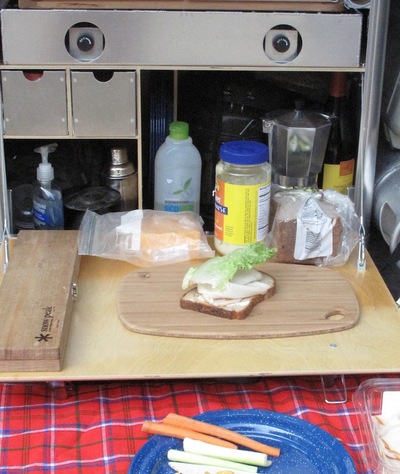 The drawers swallow all our utensils, coffee mugs, and even a folding Sea to Summit bucket. A full-sized cook kit from Snow Peak, an espresso maker, bottle of wine, dish soap, six plates, a full set of spices, coffee making filter, and martini shaker round out the kit, with room to spare. an optional certified-bear-safe unit. The 2 side shelves which are optional are very handy.
The drawers swallow all our utensils, coffee mugs, and even a folding Sea to Summit bucket. A full-sized cook kit from Snow Peak, an espresso maker, bottle of wine, dish soap, six plates, a full set of spices, coffee making filter, and martini shaker round out the kit, with room to spare. an optional certified-bear-safe unit. The 2 side shelves which are optional are very handy.
The only thing I found curiously lacking was a paper towel holder. A simple holder that would hang under a side shelf would be great. In keeping with Kanz’ environmentally aware design, perhaps this is by design—a gentle reminder I should be using washable towels instead, but I hate smelly kitchen towels when on camping trips.
I used the kitchen out of the back of the Land Cruiser, facing outwards, for fixing lunch on a recent science expedition into the Sierra Madre backcountry in Mexico. Sitting next to the ARB fridge, the top area was very convenient for setting things when they came out of the fridge, and the fold-down work surface perfect for making sandwiches.
For our camp, it’s easier to pull the kitchen out and use it on its legs, rather than on the tailgate. I like the longer legs, but the height of the stove makes it little harder to use big pots; it’s an adjustment to the usual tailgate-height or height of your at-home stove, but it’s do-able considering the convenience. We use the stove with our aluminum propane cylinder, the same one Kanz sells (he actually got the idea from Jonathan’s article on propane systems in Overland Journal). I have yet to put a mount into the back of my Land Cruiser for the cylinder, but I plan to (Kanz also sells this . . .).
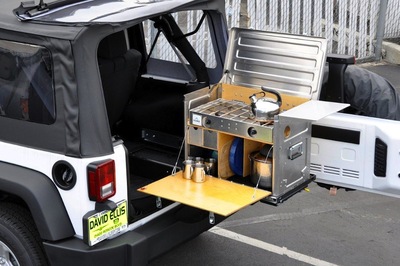 On Tembo Tusk's side-out slide.The Kanz Field Kitchen is large enough that, with the ARB fridge in the back of the Land Cruiser, it fills the back, with no room for our nice stainless steel water tank (we had to resort to using the Rhino plastic jug, the horror!). For ultimate convenience we are working on a layout that would allow us to mount the water tank as well as the fridge and Kanz Field Kitchen on pull-out runners, but we haven’t quite sorted it out.
On Tembo Tusk's side-out slide.The Kanz Field Kitchen is large enough that, with the ARB fridge in the back of the Land Cruiser, it fills the back, with no room for our nice stainless steel water tank (we had to resort to using the Rhino plastic jug, the horror!). For ultimate convenience we are working on a layout that would allow us to mount the water tank as well as the fridge and Kanz Field Kitchen on pull-out runners, but we haven’t quite sorted it out.
Kanz does sell Tembo Tusk's superb quality sliders (side-out or front-out) for the Field Kitchen. Though expensive and heavy, they are the best available and really add to the utility of the kitchen. 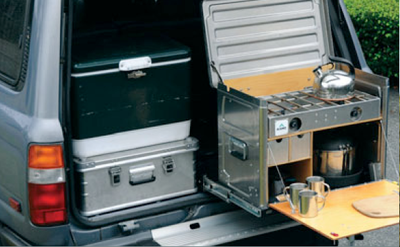 On Tembo Tusk's front-out slide.
On Tembo Tusk's front-out slide.
Kanz accessories include a matching pantry box and a bridge / work surface that joins the two. Thinking of everything (so German!), Kanz also sells wall mounts, a soft cover for transit-protection, and leather straps for horse outfitters.
They also sell my favorite food boxes: Zarges K470 aluminum cases (in photo at left, under the cooler), which are light and stack nicely. I currently use one for my own pantry, with a collapsible metal stand (an old Coleman stove stand), and it matches the Kanz Field Kitchen nicely.
I was ready to find the Kanz Kitchen lacking in comparison to my old dear ones, if only out of loyalty, but I could not: it’s a new classic, ready to fill the old shoes with honor. The price is, of course, daunting, and could be off-putting for some. But with absolute top-quality, made-in-America workmanship, exceptional materials, fit, and finish, it is worth every penny. A field kitchen is, after all, more than just a place to store your kitchen gear. With time and use, it will store many wonderful memories, of good times and beautiful places with special friends.
Specifications, Kanz Field Kitchen:
Outside Dimensions (H x W x D): 19.4 in x 25.4 in x 15.00 in, (492 mm x 645 mm x 381 mm)
Inside Dimensions of stove compartment (H x W x D): 6.3 in x 24.8 in x 14.0 in, (160 mm x 630 mm x 355 mm)
Inside Dimensions of silver ware drawer (H x W x D): 4.0 in x 3.8 in x 13.9 in, (100 mm x 97 mm x 353 mm)
Group size + guest: 6+2
Weight (empty): 25 lbs (12 kg)
Weight (with Partner Steel propane stove): 36 lbs (16.3 kg)
Weight (with Coleman 414 dual fuel stove): 40 lbs (18.1 kg)
Weight of optional cookware set): 16 lbs (7.3 kg)
Table top height (on long leg set): 26 in (660 mm)
Counter top height (long leg ; short leg set): 43 in (109 mm); 37 in (940 mm)
Transport: One foldable sprung handle on each side with rubber grip
Material: Baltic birch plywood riveted to marine grade aluminum panels
Finish: Polyurethane clear coat on wood panels inside and outside
Price without stove or cooking set: $595
Price as tested (with Partner Steel Stove and complete cooking set): $1399
A home in the bed of your truck: Four Wheel Campers
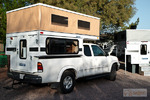 FWC has been an OX sponsor since the beginning.
FWC has been an OX sponsor since the beginning.
Over the years, we have been through a lot of vehicle-based camping setups, beginning with a couple of sleeping bags rolled out on the roof rack of my FJ40. We’ve gone minimalist with backpacking tents and stoves, luxurious with family-sized cabin tents and padded cots. We’ve tried roof tents, trailers, truck-bed mattresses. For some time we owned a WilderNest, a pickup shell with a cunning roof that flipped sideways to turn into a bed, with an enormous tent erected semi-automatically above it. I remember spending a mostly sleepless night trying to brace the frame of that spinnaker-like tent in a 40mph Sea of Cortez Norte. It was never quite the same afterward. Of all the setups that have come and gone, the one about which we wax most nostalgic is our Four Wheel Camper. Mounted first on a 1990 4WD Toyota pickup powered by a willing but overmatched 22RE four-cylinder, then on a 2000 4WD Tacoma with the 3.4-liter six (60 percent more power and better gas mileage), we put over 150,000 miles on that camper, using it as a mobile base for dozens of freelance magazine assignments and several books.
 FWC has been an OX sponsor since the beginning.
FWC has been an OX sponsor since the beginning.
Over the years, we have been through a lot of vehicle-based camping setups, beginning with a couple of sleeping bags rolled out on the roof rack of my FJ40. We’ve gone minimalist with backpacking tents and stoves, luxurious with family-sized cabin tents and padded cots. We’ve tried roof tents, trailers, truck-bed mattresses. For some time we owned a WilderNest, a pickup shell with a cunning roof that flipped sideways to turn into a bed, with an enormous tent erected semi-automatically above it. I remember spending a mostly sleepless night trying to brace the frame of that spinnaker-like tent in a 40mph Sea of Cortez Norte. It was never quite the same afterward. Of all the setups that have come and gone, the one about which we wax most nostalgic is our Four Wheel Camper. Mounted first on a 1990 4WD Toyota pickup powered by a willing but overmatched 22RE four-cylinder, then on a 2000 4WD Tacoma with the 3.4-liter six (60 percent more power and better gas mileage), we put over 150,000 miles on that camper, using it as a mobile base for dozens of freelance magazine assignments and several books.
At the time, we lived on a wildlife refuge seven miles down a rough dirt road, so even driving to town for groceries gave the rig a workout. Nevertheless, the sum total of my repairs to that camper was a rebuild of the door, which had begun to sag and needed reinforcing.
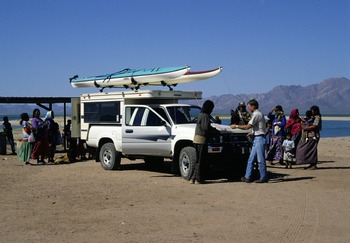 Our FWC in the 1990s, Punta Chueca, Sonora, Mexico, visiting Seri Indian country.We loved the FWC’s 30-second transformation into a full-standing-headroom camper with queen-sized bed, fridge, sink, and stove, and a comfortable settee. Sit-down snack at a rest stop on a highway trip? Easy. A couple of years into ownership, we experienced another Sea of Cortez Norte more furious than the first—and slept like babes. The pop-up roof didn’t even quiver. Despite the comfort and strength, the camper’s relatively feathery, aluminum-framed 700 pounds barely taxed the truck, and never kept us from reaching secluded backcountry hideouts.
Our FWC in the 1990s, Punta Chueca, Sonora, Mexico, visiting Seri Indian country.We loved the FWC’s 30-second transformation into a full-standing-headroom camper with queen-sized bed, fridge, sink, and stove, and a comfortable settee. Sit-down snack at a rest stop on a highway trip? Easy. A couple of years into ownership, we experienced another Sea of Cortez Norte more furious than the first—and slept like babes. The pop-up roof didn’t even quiver. Despite the comfort and strength, the camper’s relatively feathery, aluminum-framed 700 pounds barely taxed the truck, and never kept us from reaching secluded backcountry hideouts.
Gripes? Sure, we had a few. The water tank was too small and mounted too high. The main cabinet doors were flimsy sliding panels of 1/8th-inch plywood. And the three-way fridge gave up even slightly cooling its contents in any ambients over 90ºF. But they were tiny gripes compared to the consummate ease of pulling into a camp spot and having a home ready in less than a minute.
I write this up front so you don’t think what follows is some slavish encomium concocted in trade for sponsorship or ad revenue: We developed our enthusiasm for Four Wheel Campers the old-fashioned way—at full retail. So we jumped at the chance to make a second pilgrimage to the factory in Woodland, California, to visit with owners Tom and Celeste Hanagan, who’ve become good friends over the years. (Alas, this time we weren’t there to pick up a new camper.)
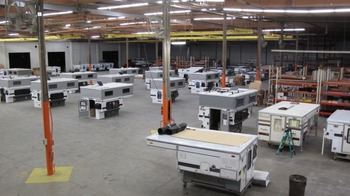 New factory floor in Woodland, CA. Older models belonging to customers, in for modifications or repairs after accidents, are in the lower right.Actually, it’s a different factory, significantly larger than the old one. A good thing, it seemed, because the space was clearly being utilized to the fullest already. A triple row of campers, aligned as if by laser, stood waiting for successive construction steps, from welding of the bare, elegant aluminum frame to final touches in flooring and lighting. There’s now more room for the ancillary shops such as upholstery and carpentry, which were formerly wedged into corners.
New factory floor in Woodland, CA. Older models belonging to customers, in for modifications or repairs after accidents, are in the lower right.Actually, it’s a different factory, significantly larger than the old one. A good thing, it seemed, because the space was clearly being utilized to the fullest already. A triple row of campers, aligned as if by laser, stood waiting for successive construction steps, from welding of the bare, elegant aluminum frame to final touches in flooring and lighting. There’s now more room for the ancillary shops such as upholstery and carpentry, which were formerly wedged into corners.
Most interestingly, I got an inside look—literally—at the evolution of the Four Wheel Camper under Tom and Celeste’s guidance. The small, high-mounted water tank I mentioned on ours? It’s been nearly doubled in size (now 22 gallons) and moved to the floor under a settee at the front of the camper, perfect for weight distribution. The cabinets now have proper hinged doors. The fridge option now includes a compressor-driven unit guaranteed not to go on strike in summer. And the corners of the main entrance door have been radiused to add significant rigidity.
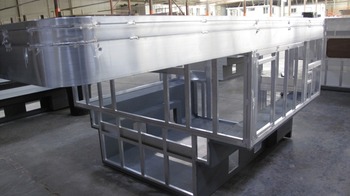 The amazing aluminum frame, a work of art.There was more. The roof—which on ours comprised three sections, yet never leaked despite the fact that I through-drilled it to mount racks for our sea kayaks—is now a one-piece, screw-free aluminum sheet that can’t leak. Much of the interior plywood is now superb multi-laminate European birch; exterior insulation is now rigid foam rather than fiberglass. Appliances have been upgraded, headroom augmented without changing the travel profile, the dining table is now a portable unit that can be used outside—nothing seemed to have escaped scrutiny and improvement.
The amazing aluminum frame, a work of art.There was more. The roof—which on ours comprised three sections, yet never leaked despite the fact that I through-drilled it to mount racks for our sea kayaks—is now a one-piece, screw-free aluminum sheet that can’t leak. Much of the interior plywood is now superb multi-laminate European birch; exterior insulation is now rigid foam rather than fiberglass. Appliances have been upgraded, headroom augmented without changing the travel profile, the dining table is now a portable unit that can be used outside—nothing seemed to have escaped scrutiny and improvement.
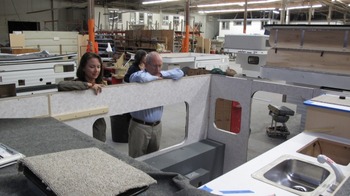 Tom and Roseann looking at an interior under construction.A lot of those improvement can even be applied to older Four Wheel Campers. In a corner of the factory was a cluster of customer-owned campers in various stages of repair and renewal. One vintage model at least 20 years old was receiving a new one-piece roof; others were having skins, water tanks, upholstery, or appliances replaced and updated. It was a reminder that a Four Wheel Camper is a genuine investment—as if prices on the used market weren’t reminder enough. We sold ours (to pay off our land) for 85 percent of what we paid for it new, despite all the use and mileage.
Tom and Roseann looking at an interior under construction.A lot of those improvement can even be applied to older Four Wheel Campers. In a corner of the factory was a cluster of customer-owned campers in various stages of repair and renewal. One vintage model at least 20 years old was receiving a new one-piece roof; others were having skins, water tanks, upholstery, or appliances replaced and updated. It was a reminder that a Four Wheel Camper is a genuine investment—as if prices on the used market weren’t reminder enough. We sold ours (to pay off our land) for 85 percent of what we paid for it new, despite all the use and mileage.
Ack. I just reminded myself that we sold it. Take my advice: If you buy one, keep it. Who needs land if you have a home on wheels?
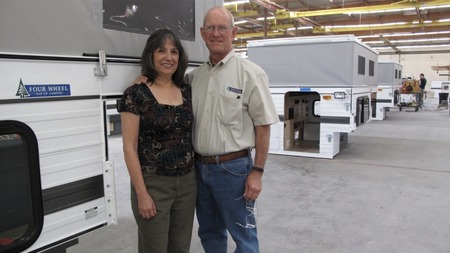 Tom and Celeste Hanagan, the power duo behind the quality and success of Four Wheel Campers.
Tom and Celeste Hanagan, the power duo behind the quality and success of Four Wheel Campers.
What is the best simple, portable power pack?
 Do you have a recommendation for an (affordable) portable power pack, the kind that can jump-start a dead vehicle battery and power A/C off it? Basically a portable car battery. I had a Statpower Portawattz for the last 10 years that has served me well, but I am looking to replace it. It was around $100 +/- and looking to stay in that range. Thought you all might be able to recommend a brand.
Do you have a recommendation for an (affordable) portable power pack, the kind that can jump-start a dead vehicle battery and power A/C off it? Basically a portable car battery. I had a Statpower Portawattz for the last 10 years that has served me well, but I am looking to replace it. It was around $100 +/- and looking to stay in that range. Thought you all might be able to recommend a brand.Eric Wallace
Swedish steel meets English wood
(WARNING: If you are annoyed by unapologetic encomiums to fine, hand-crafted tools made one at a time by one person at a time, do not read further!)
Some time ago I splurged on a Gränsfors Bruks Scandinavian Forest Axe, after eyeing them for years. If you aren’t familiar with the brand, Gränsfors Bruks has been making axes and hatchets in Sweden since 1902. While countless other companies—including some fine American brands—gradually sacrificed quality for quicker, cheaper production, Gränsfors Bruks took a step backward in the 1980s and returned to making only best-quality tools. Craftsmen in the forge in Hälsingland stand before fearsome flywheel-driven trip hammers to form the heads, then stamp their initials in the steel (mine was made by Kjell-Åke Sjölund). After annealing, tempering, and sharpening, an oiled hickory handle is inserted with a hydraulic press, then fixed with two wedges, one wood and one steel.
The result is as elemental a tool as humans can make, the latest iteration in an unbroken line dating to the first time a Neolithic tinkerer lashed a knapped hunk of flint to a stick and discovered the magic of force multiplication.
My Scandinavian Forest Axe looks almost dainty next to a standard American felling axe (which Gränsfors Bruks also makes, along with such intriguing anachronisms as throwing axes and replicas of 7th-century bearded axes). Just 25 inches long and 2.6 pounds, I can choke up on it one-handed to lop small limbs off a larger branch, or back off to a two-fisted grip and power through a six-inch-diameter trunk in 30 seconds flat. It wouldn’t be my first choice for building a Dick Proenneke-style cabin in the North Woods, but if pressed it could probably handle it—and it’s nearly perfect for every job I’m likely to encounter around the house or on an overland journey.
But . . . sometimes you need a saw.
(WARNING: If you are annoyed by unapologetic encomiums to fine, hand-crafted tools made one at a time by one person at a time, do not read further!)
Some time ago I splurged on a Gränsfors Bruks Scandinavian Forest Axe, after eyeing them for years. If you aren’t familiar with the brand, Gränsfors Bruks has been making axes and hatchets in Sweden since 1902. While countless other companies—including some fine American brands—gradually sacrificed quality for quicker, cheaper production, Gränsfors Bruks took a step backward in the 1980s and returned to making only best-quality tools. Craftsmen in the forge in Hälsingland stand before fearsome flywheel-driven trip hammers to form the heads, then stamp their initials in the steel (mine was made by Kjell-Åke Sjölund). After annealing, tempering, and sharpening, an oiled hickory handle is inserted with a hydraulic press, then fixed with two wedges, one wood and one steel.
The result is as elemental a tool as humans can make, the latest iteration in an unbroken line dating to the first time a Neolithic tinkerer lashed a knapped hunk of flint to a stick and discovered the magic of force multiplication.
My Scandinavian Forest Axe looks almost dainty next to a standard American felling axe (which Gränsfors Bruks also makes, along with such intriguing anachronisms as throwing axes and replicas of 7th-century bearded axes). Just 25 inches long and 2.6 pounds, I can choke up on it one-handed to lop small limbs off a larger branch, or back off to a two-fisted grip and power through a six-inch-diameter trunk in 30 seconds flat. It wouldn’t be my first choice for building a Dick Proenneke-style cabin in the North Woods, but if pressed it could probably handle it—and it’s nearly perfect for every job I’m likely to encounter around the house or on an overland journey.
But . . . sometimes you need a saw.
An axe is unexcelled at certain tasks: splitting logs, quickly trimming branches off larger limbs, notching logs, cutting through green wood that can bind a saw, or sharpening stakes made from branches. Of course your axe also makes a decent hammer for pounding in those stakes.

A saw is a more precise instrument. It’s generally faster for cutting through dry wood, and produces less waste. If you need to trim trailside overgrowth, a saw can take off a limb surgically at the node, leaving the shrub or tree looking more natural.
The axe is of course the more “dangerous” tool, capable of cleaving tibias as well as trees. However, while I’ve never experienced an injury from a hatchet or axe, I have suffered innumerable nasty tearing cuts from carelessly handled saws, and my acquaintances report similar histories. I theorize the perceived “danger” in swinging an axe might induce sensible people to be more careful with it than they are with a saw. So I’ll call that comparison a draw—as long as you use both tools properly.
So—which saw to carry with my fine Swedish axe?
I own a couple of good folding saws—a Gerber Sports Saw and a Bahco Laplander. Both are excellent for limbs up to about three inches in diameter, and the compact configuration allows them to fit into tight spots. But they’re fairly light-duty tools. For bigger logs, and more comfortable extended use, I prefer a bow or buck saw, and since the buck saw can be broken down, it makes the most sense for a vehicle.
I looked at the clever Trail Blazer buck saw, which collapses to fit into its own handle tube. However, its 18-inch blade offers little advantage over a folding saw. Besides, as a companion to the Gransfors axe its all-metal construction seemed rather soulless. What I needed was a wood-framed model. I thought I had it when I browsed through the Lehman’s site (lehmans.com) and discovered their beautiful hickory buck saws, which are made by a local Amish craftsman. Excellent—except the Lehman’s saw wasn’t designed to be broken down quickly, and its 28-inch blade rendered it a bit too large for most field use.
Finally, a burst of recovered memory led me to the Woodlore site (raymears.com) in England. Founded by Ray Mears, the avuncular English survival expert whose television programs are a refreshing antidote to the gritted-teeth epics from the strictly-for-entertainment bug-eating fringe, Woodlore’s online shop offers a modest selection of high-quality gear—and in the saw section, there it was.
The Woodlore folding buck saw collapses in seconds when not in use, and the just-right 24-inch blade is tensioned with a simple Spanish windlass arrangement, which helps keep total weight down to less than two pounds including a fine canvas and leather case that incorporates a slot for the saw and another that accepts—ready?—a Gränsfors Bruks Scandinavian Forest Axe.
Sold.
Not that I needed more convincing, but I was pleased to discover the Woodlore saw is made by Chris Boyton, an English longbow maker well known to me (I once made my own longbow, and Chris’s work was an inspiration and template). The wood is light but strong European beech of excellent, straight grain, and the included Bahco blade simply whizzes through logs up to five inches in diameter without shifting, or ten inches if you roll it and make a second cut from the other side.
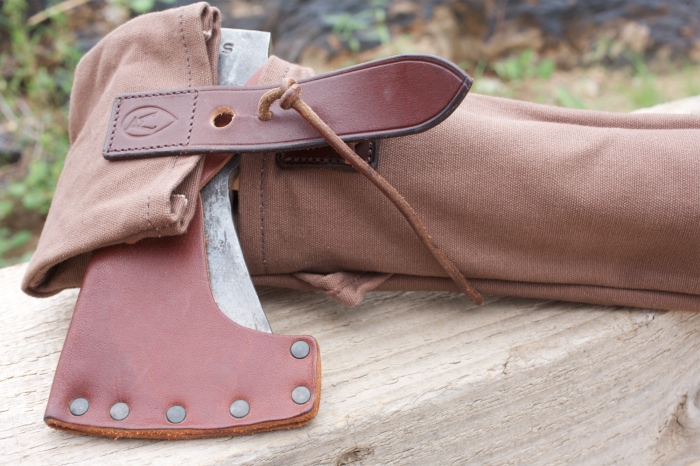 So now I’m delighted to own an elegant pairing of axe and saw that carry together perfectly, complement each other’s strengths, and should last a lifetime. And I know the names of the craftsmen who made each one—a rare thing in our world.
So now I’m delighted to own an elegant pairing of axe and saw that carry together perfectly, complement each other’s strengths, and should last a lifetime. And I know the names of the craftsmen who made each one—a rare thing in our world.
Equipment review: micro stoves, part 1 of 3
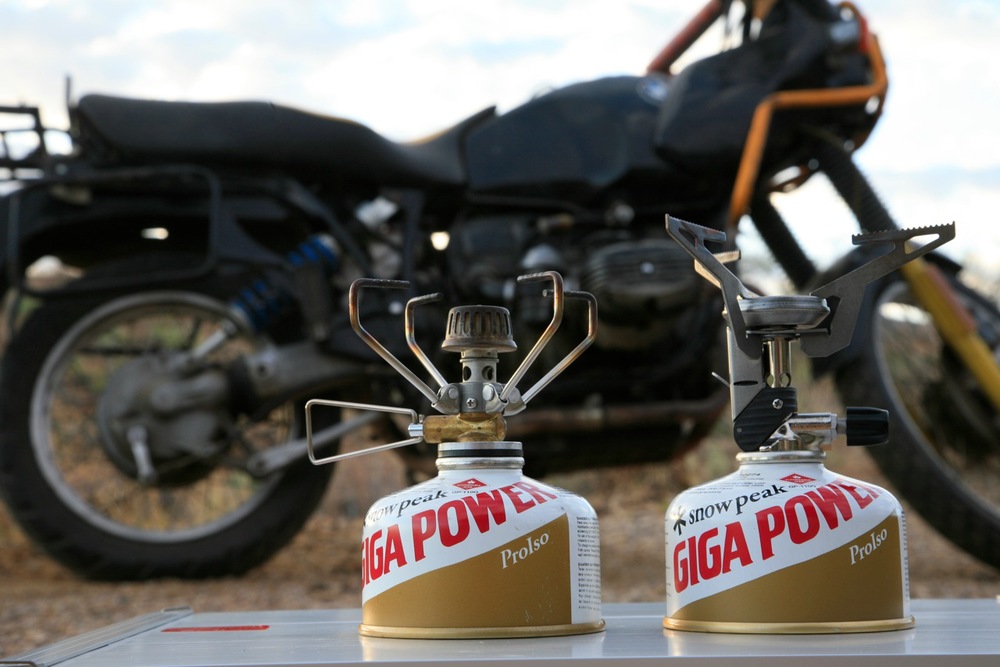 Let’s be frank here: Adventure motorcyclists are essentially divided into two species—those who ride a BMW R1150GS or R1200GS, and those who ride anything else (including other BMWs). We can argue about whether or not the big GS bikes are the best adventure motorcycles on the planet, but you can’t deny they’re the most prominent, and their fans make the most zealous Sturgis-tattooed Harley rider seem fickle.
Let’s be frank here: Adventure motorcyclists are essentially divided into two species—those who ride a BMW R1150GS or R1200GS, and those who ride anything else (including other BMWs). We can argue about whether or not the big GS bikes are the best adventure motorcycles on the planet, but you can’t deny they’re the most prominent, and their fans make the most zealous Sturgis-tattooed Harley rider seem fickle.
To continue the Linnaean angle, the mega-GS riders I know generally separate into two sub-species when considering camping equipment: They either think, I’m riding a zillion-pound motorcycle. What difference does it make what my equipment weighs? Or, I’m riding a zillion-pound motorcycle. I need to save every gram I can on equipment.
If you’re a member of the former group, and you’re in the market for a stove, I can happily recommend a three-burner Partner Steel model, which will strap on your rear luggage rack with room to spare. A 20-pound propane tank should give you plenty of cooking fuel. For the latter group—or any of you who ride mere mortal motorcycles, I offer a review (the first of three, with a final winner to be chosen) of two micro stoves.
 Let’s be frank here: Adventure motorcyclists are essentially divided into two species—those who ride a BMW R1150GS or R1200GS, and those who ride anything else (including other BMWs). We can argue about whether or not the big GS bikes are the best adventure motorcycles on the planet, but you can’t deny they’re the most prominent, and their fans make the most zealous Sturgis-tattooed Harley rider seem fickle.
Let’s be frank here: Adventure motorcyclists are essentially divided into two species—those who ride a BMW R1150GS or R1200GS, and those who ride anything else (including other BMWs). We can argue about whether or not the big GS bikes are the best adventure motorcycles on the planet, but you can’t deny they’re the most prominent, and their fans make the most zealous Sturgis-tattooed Harley rider seem fickle.
To continue the Linnaean angle, the mega-GS riders I know generally separate into two sub-species when considering camping equipment: They either think, I’m riding a zillion-pound motorcycle. What difference does it make what my equipment weighs? Or, I’m riding a zillion-pound motorcycle. I need to save every gram I can on equipment.
If you’re a member of the former group, and you’re in the market for a stove, I can happily recommend a three-burner Partner Steel model, which will strap on your rear luggage rack with room to spare. A 20-pound propane tank should give you plenty of cooking fuel. For the latter group—or any of you who ride mere mortal motorcycles, I offer a review (the first of three, with a final winner to be chosen) of two micro stoves.
We've Come a Long Way
My first backpacking stove was a beautiful little white gas SVEA 123, considered “light” at the time despite being made from solid brass, which has a density not far this side of neutron star core material.
How times have changed. Compare the 18-ounce heft of that SVEA with the 1.9 ounces of a Snow Peak LiteMax Titanium stove. Sure, the LiteMax has no built-in fuel tank, but add a full canister of isobutane/propane mix and you’re only up to 8.5 ounces, less than half the mass of the empty SVEA.
However, as important as weight is to a motorcycle traveler, it’s not the only consideration when choosing a stove. Stability, efficiency, wind resistance, boiling time, and simmering ability all factor in as well.
Furthermore, weight can be deceptive. Canister stoves are virtually always lighter than liquid-fuel stoves even with a canister attached, since they require no pumping mechanism—but for most trips you’ll need more than one canister, and the weight (and bulk) of them adds up quickly.
Then there’s disposal: Recycling spent canisters is an on-again, off-again possibility in many communities. Sometimes they’re just trash. (JetBoil makes an excellent tool for puncturing empty canisters, required for recycling in most areas.)
First in a Series of Stove Duels
I decided to take a highly opinionated, who-made-you-the-expert? stab at pronouncing which is the best lightweight stove on the market. However, rather than review every single one of the dozens of models available, I’m cheating a bit—I’ve chosen what fairly broad experience has led me to believe are:
- Two of the best top-mounted canister stoves
- Two of the best remote-canister stoves, and
- Two of the best liquid-fuel stoves.
The winner of each duel will face off in the final.
I looked at top-mounted canister stoves first. The major advantages and disadvantages of this style can be summarized thusly:
Advantages:
- Extremely lightweight and compact
- Extremely simple to assemble and operate
- Quiet and clean-burning
- Excellent simmering ability
- Most affordable to purchase
Disadvantages:
- Least stable of three stove types
- Marginal cold-weather performance even with mixed fuel
- Canisters are bulky on long trips
- Susceptible to wind (and care must be used with wind deflectors to avoid overheating of the canister)
- Generally slower boil times than liquid-fuel stoves (although speed of assembly and lighting compensates)
- Difficult to quantify remaining fuel
- Fuel costs are higher
- Canisters often not available in developing countries
Of all the top-mounted canister stoves I’ve used, I like the Primus Express Stove and the Snow Peak GigaPower the best, for their light weight, simplicity, and affordability.
 Primus Express Stove (on Snow Peak canister), $54
Primus Express Stove (on Snow Peak canister), $54 Snow Peak Gigapower (above right), $40 ($50 w/pietzo)
Snow Peak Gigapower (above right), $40 ($50 w/pietzo)
The Express also comes in a titanium version, but the scant .4 ounce saving (2.5 versus 2.9) isn’t worth the extra $20 to me—that’s a set of titanium utensils which would save more weight. Snow Peak has the fine newer (and slightly lighter) LiteMax, but I prefer the four-trivet stove base on the GigaPower, and it folds more compactly as well.
There are other good stoves out there. The JetBoil is absolutely fabulous at boiling water quickly, but I find the system cumbersome for general cooking duties, and even its titanium versions are fairly heavy. The MSR Pocket Rocket was a contender, only passed over because—just once—I had one of its three trivets fold up on me while I was setting a pot on top, and almost lost the whole thing. Another near miss was the Optimus Crux Lite—an excellent stove that is a champ at simmering, except I’ve occasionally had the flame die unnoticed when on its lowest setting.
So—let’s decide between these two. Both are designed to use standard Lindal-valve canisters, and each company’s proprietary canisters contain an isobutane/propane mix, which enhances low-temperature performance (pure propane would be best as its boiling point is -40ºF versus butane’s +31ºF, but pure propane requires a stout steel canister).
 Snow Peak Gigapower (above right)Weight difference is negligible: 3.25 ounces for the Snow Peak versus 3 ounces for the Primus. However, my Primus includes a piezo igniter; the equivalent GigaPower is 3.75 ounces. So a slight .75-ounce nod goes to the Primus here.
Snow Peak Gigapower (above right)Weight difference is negligible: 3.25 ounces for the Snow Peak versus 3 ounces for the Primus. However, my Primus includes a piezo igniter; the equivalent GigaPower is 3.75 ounces. So a slight .75-ounce nod goes to the Primus here.
Both stoves are effortless and speedy to employ. Less than 30 seconds out of the stuff sack for either and you’re cooking.
I timed boiling for each, using 500 ml of water (note my commitment to scientific rigor by using 500 milliliters rather than a crude pint) in my favorite do-it-all solo pot/kettle/bowl, an MSR titanium Titan.
The GigaPower accomplished the task in 3 minutes, 13 seconds; the Primus was slightly quicker at 3 minutes, 7 seconds. Again, a slight nod to the Primus. (I used Snow Peak canisters for both to eliminate differences in fuel. I suppose Primus could protest, but since their stove was faster anyway . . .) Both stoves simmer extremely well, but the burner of the GigaPower spreads the flame over a wider area, so it wins there.
Stability on top-mounted canister stoves is marginal at best. You should always provide a flat, firm surface for this type of stove. (I discovered the Snow Peak Baja Table while I was sea kayaking. It’s a cunning aluminum contraption that’s just high enough to get food prep and cooking off the ground, and which doubles elegantly as a cocktail table for a Kermit Chair.)
The Primus has a wider trivet assembly then the GigaPower, but the latter has four trivets versus three, which I find adds security. More importantly, the Primus, at 14.5 centimeters tall, sits 1.8 cm higher than the Snow Peak—almost three-quarters of an inch. That might not seem like much, but with these tippy stoves every bit helps. Win to Snow Peak.
What else? The wire-loop valve on the Snow Peak sticks out farther than the plastic knob on the Primus, so you don’t have to get your hand so near to the flame to adjust it. Both stoves fold very small, but the GigaPower collapses into a symmetrical shape, while the three trivets on the Optimus protrude somewhat even when folded, creating slightly awkward storage inside a pot.
Since I already knew I liked both these stoves, choosing between them was difficult. I’d happily carry either, and do. But when the time came to pick one, my hand finally strayed to the Snow Peak GigaPower. Its balance of features and performance tipped the scales ever so slightly.
Next time we’ll look at two of the best remote canister stoves on the market.
What is the safest way to carry enough water for an extended trip?
For years I've been getting by with using the big plastic water containers from Reliance. But now that I'm planning an extended trip into Baja this fall, I thought I'd better get a jump on better options. Any thoughts on the safest way to carry enough water for an extended trip?
- Tony in Los Angeles, via Twitter
Overland skills: Fire without matches
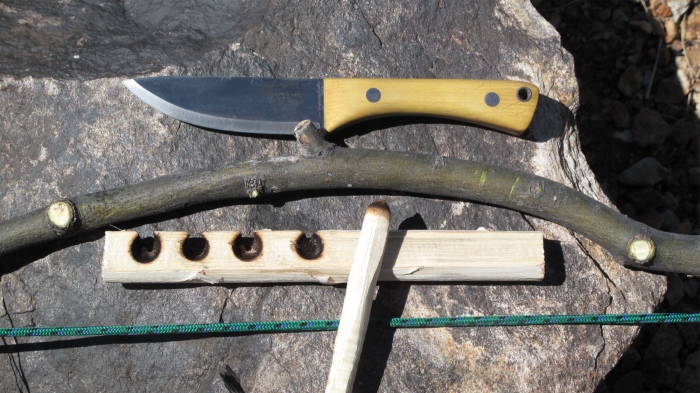 I’ve always been fascinated by bushcrafting - those guys who can build a shelter, gather and trap food, and make a fire with nothing but a knife. The firemaking part always seemed the most magical, so finally I decided to try it, using the bow drill method.
I’ve always been fascinated by bushcrafting - those guys who can build a shelter, gather and trap food, and make a fire with nothing but a knife. The firemaking part always seemed the most magical, so finally I decided to try it, using the bow drill method.
The material of choice here in southern Arizona is sotol, a plant in the agave family that grows at elevations over 3,800 feet or so. Specifically you want the dried flower stalk, which forms a tough, fibrous pole. I hiked up the hill to the south of us and brought back a few, then prepared, first, a hearth by splitting a length to get a flat piece, then a spindle by smoothing out a narrower piece near the tip.
 I’ve always been fascinated by bushcrafting - those guys who can build a shelter, gather and trap food, and make a fire with nothing but a knife. The firemaking part always seemed the most magical, so finally I decided to try it, using the bow drill method.
I’ve always been fascinated by bushcrafting - those guys who can build a shelter, gather and trap food, and make a fire with nothing but a knife. The firemaking part always seemed the most magical, so finally I decided to try it, using the bow drill method.
The material of choice here in southern Arizona is sotol, a plant in the agave family that grows at elevations over 3,800 feet or so. Specifically you want the dried flower stalk, which forms a tough, fibrous pole. I hiked up the hill to the south of us and brought back a few, then prepared, first, a hearth by splitting a length to get a flat piece, then a spindle by smoothing out a narrower piece near the tip.
The next step is the key. You start a depression for the spindle in the hearth with the tip of your knife, then twist the spindle into it to smooth it. Then you must cut a notch in the side that just intersects the depression, and which widens at the bottom. The ember which is the aim of the procedure gathers in this notch, and you then transfer the ember to your tinder bundle.
I cheated by using a synthetic rope for the bow, rather than stripping agave leaves with my teeth to braid one (next time). The bow was a length of mesquite.
It took four tries to get a good ember in the notch, but it died when I transfered it to my dried grass tinder bundle and blew on it. Finally, on the eighth try, the tinder bundle burst into flame. It was so cool I whooped out loud.
Next I want to try the hand drill method, which obviates the need for the bow and string. Report to follow. New class at the Overland Expo?
Hint: When using “Search,” if nothing comes up, reload the page, this usually works. Also, our “Comment” button is on strike thanks to Squarespace, which is proving to be difficult to use! Please email me with comments!
Overland Tech & Travel brings you in-depth overland equipment tests, reviews, news, travel tips, & stories from the best overlanding experts on the planet. Follow or subscribe (below) to keep up to date.
Have a question for Jonathan? Send him an email [click here].
SUBSCRIBE
CLICK HERE to subscribe to Jonathan’s email list; we send once or twice a month, usually Sunday morning for your weekend reading pleasure.
Overland Tech and Travel is curated by Jonathan Hanson, co-founder and former co-owner of the Overland Expo. Jonathan segued from a misspent youth almost directly into a misspent adulthood, cleverly sidestepping any chance of a normal career track or a secure retirement by becoming a freelance writer, working for Outside, National Geographic Adventure, and nearly two dozen other publications. He co-founded Overland Journal in 2007 and was its executive editor until 2011, when he left and sold his shares in the company. His travels encompass explorations on land and sea on six continents, by foot, bicycle, sea kayak, motorcycle, and four-wheel-drive vehicle. He has published a dozen books, several with his wife, Roseann Hanson, gaining several obscure non-cash awards along the way, and is the co-author of the fourth edition of Tom Sheppard's overlanding bible, the Vehicle-dependent Expedition Guide.

